Abstract
A variable dimension algorithm is presented for the linear complementarity problems − Mz = q; s,z ≥ 0; s i z i = 0 fori = 1,2, ⋯ ,n. The algorithm solves a sequence of subproblems of different dimensions, the sequence being possibly nonmonotonic in the dimension of the subproblem solved. Every subproblem is the linear complementarity problem defined by a leading principal minor of the matrixM. Index-theoretic arguments characterize the points at which nonmonotonic behavior occurs.
Similar content being viewed by others
References
R.W. Cottle, “Completely-Q matrices”,Mathematical Programming 19 (1980) 347–351.
R.W. Cottle and G.B. Dantzig, “Complementary pivot theory of mathematical programming”,Linear Algebra and Its Applications 1 (1968) 103–125.
G.B. Dantzig,Linear programming and extensions (Princeton University Press, Princeton, NJ, 1963).
B.C. Eaves, “The linear complementarity problem”,Management Science 17 (1971) 612–634.
B.C. Eaves and H. Scarf, “The solution of systems of piecewise linear equations”,Mathematics of Operations Research 1 (1976) 1–31.
C.E. Lemke, “Bimatrix equilibrium points and mathematical programming”,Management Science 11 (1965) 681–689.
C.E. Lemke, “Some pivot schemes for the linear complementarity problem”, in: M.L. Balinski and R.W. Cottle, eds.,Mathematical programming study 7:Complementarity and fixed points problems (North-Holland, Amsterdam, 1978) pp. 15–35.
C.E. Lemke and S.J. Grotzinger, “On generalizing Shapley's index theory to labelled pseudomanifolds”,Mathematical Programming 10 (1976) 245–262.
C.E. Lemke and J.T. Howson, “Equilibrium points and bimatrix games”,SIAM Journal of Applied Mathematics 12 (1964) 413–423.
H. Scarf, with the collaboration of T. Hansen,The computation of economic equilibria (Yale University Press, New Haven, CT, 1973).
L.S. Shapley, “On balanced games without side payments”, in: T.C. Hu and S.M. Robinson, eds.,Mathematical programming (Academic Press, New York, 1973) pp. 261–290.
L.S. Shapley, “A note on the Lemke—Howson algorithm”, in: M.L. Balinski, ed.,Mathematical programming study 1:Pivoting and extensions (North-Holland, Amsterdam, 1974) pp. 175–189.
A. Stickney and L. Watson, “Digraph models of Bard-type algorithms for the linear complementarity problem”,Mathematics of Operations Research 3 (1978) 322–333.
L. Van der Heyden, “Refinement methods for computing fixed points using primitive sets”, Dissertation, Yale University, New Haven, CT (1979).
Author information
Authors and Affiliations
Rights and permissions
About this article
Cite this article
Van der Heyden, L. A variable dimension algorithm for the linear complementarity problem. Mathematical Programming 19, 328–346 (1980). https://doi.org/10.1007/BF01581652
Received:
Revised:
Issue Date:
DOI: https://doi.org/10.1007/BF01581652




